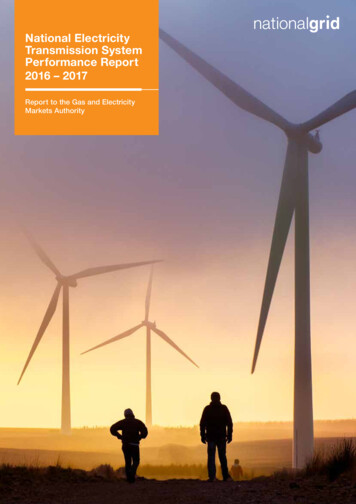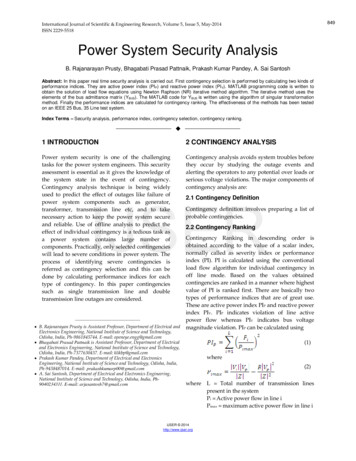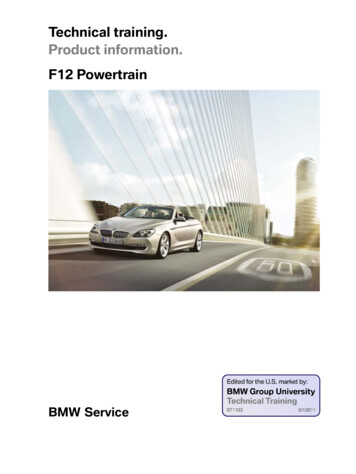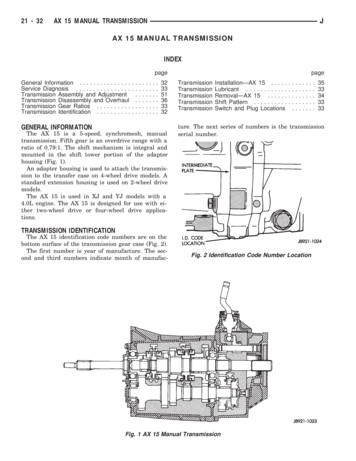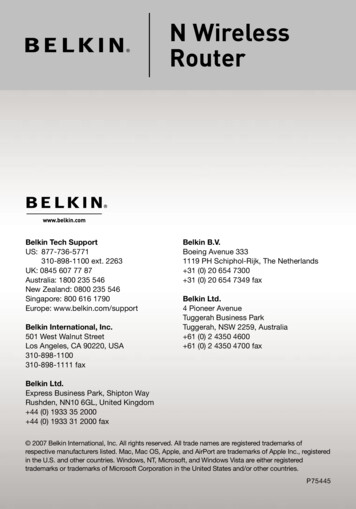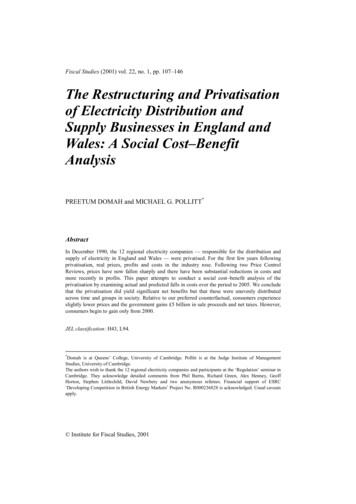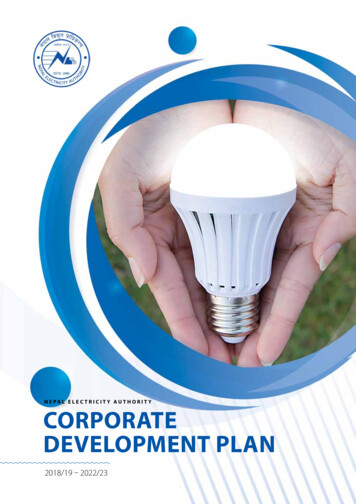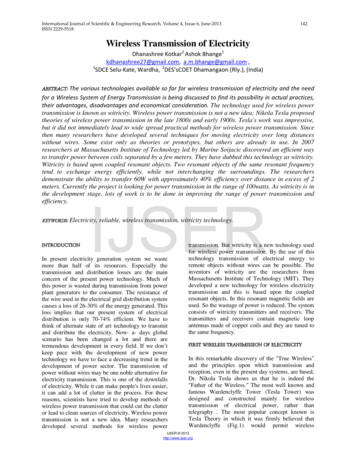
Transcription
International Journal of Scientific & Engineering Research, Volume 4, Issue 6, June-2013ISSN 2229-5518142Wireless Transmission of ElectricityDhanashree Kotkar2 Ashok Bhange1kdhanashree27@gmail.com, a.m.bhange@gmail.com ,1SDCE Selu-Kate, Wardha, 2DES’sCOET Dhamangaon (Rly.), (India)ABSTRACT: The various technologies available so far for wireless transmission of electricity and the needfor a Wireless System of Energy Transmission is being discussed to find its possibility in actual practices,their advantages, disadvantages and economical consideration. The technology used for wireless powertransmission is known as witricity. Wireless power transmission is not a new idea; Nikola Tesla proposedtheories of wireless power transmission in the late 1800s and early 1900s. Tesla's work was impressive,but it did not immediately lead to wide spread practical methods for wireless power transmission. Sincethen many researchers have developed several techniques for moving electricity over long distanceswithout wires. Some exist only as theories or prototypes, but others are already in use. In 2007researchers at Massachusetts Institute of Technology led by Marine Soijacic discovered an efficient wayto transfer power between coils separated by a few meters. They have dubbed this technology as witricity.Witricity is based upon coupled resonant objects. Two resonant objects of the same resonant frequencytend to exchange energy efficiently, while not interchanging the surroundings. The researchersdemonstrate the ability to transfer 60W with approximately 40% efficiency over distance in excess of 2meters. Currently the project is looking for power transmission in the range of 100watts. As witricity is inthe development stage, lots of work is to be done in improving the range of power transmission andefficiency.IJSERKEYWORDS: Electricity, reliable, wireless transmission, witricity technology.INTRODUCTIONIn present electricity generation system we wastemore than half of its resources. Especially thetransmission and distribution losses are the mainconcern of the present power technology. Much ofthis power is wasted during transmission from powerplant generators to the consumer. The resistance ofthe wire used in the electrical grid distribution systemcauses a loss of 26-30% of the energy generated. Thisloss implies that our present system of electricaldistribution is only 70-74% efficient. We have tothink of alternate state of art technology to transmitand distribute the electricity. Now- a- days globalscenario has been changed a lot and there aretremendous development in every field. If we don’tkeep pace with the development of new powertechnology we have to face a decreasing trend in thedevelopment of power sector. The transmission ofpower without wires may be one noble alternative forelectricity transmission. This is one of the downfallsof electricity. While it can make people's lives easier,it can add a lot of clutter in the process. For thesereasons, scientists have tried to develop methods ofwireless power transmission that could cut the clutteror lead to clean sources of electricity. Wireless powertransmission is not a new idea. Many researchersdeveloped several methods for wireless powertransmission. But witricity is a new technology usedfor wireless power transmission. By the use of thistechnology transmission of electrical energy toremote objects without wires can be possible. Theinventors of witricity are the researchers fromMassachusetts Institute of Technology (MIT). Theydeveloped a new technology for wireless electricitytransmission and this is based upon the coupledresonant objects. In this resonant magnetic fields areused. So the wastage of power is reduced. The systemconsists of witricity transmitters and receivers. Thetransmitters and receivers contain magnetic loopantennas made of copper coils and they are tuned tothe same frequency.FIRST WIRELESS TRANSMISSION OF ELECTRICITYIn this remarkable discovery of the "True Wireless"and the principles upon which transmission andreception, even in the present day systems, are based,Dr. Nikola Tesla shows us that he is indeed the"Father of the Wireless." The most well known andfamous Wardenclyffe Tower (Tesla Tower) wasdesigned and constructed mainly for wirelesstransmission of electrical power, rather thantelegraphy . The most popular concept known isTesla Theory in which it was firmly believed thatWardenclyffe (Fig.1) would permit wirelessIJSER 2013http://www.ijser.org
International Journal of Scientific & Engineering Research, Volume 4, Issue 6, June-2013ISSN 2229-5518transmission and reception across large distanceswith negligible losses. In spite of this he had madenumerous experiments of high quality to validate hisclaim of possibility of wireless transmission ofelectricity. But this was an unfortunate incidence thatpeople of that century was not in a position torecognize his splendid work otherwise today we maytransmit electricity wirelessly and will convert ourmother earth a wonderful adobe full of electricity.143Blue lines-Magnetic near fieldYellow lines- flow of energy, Power transfer is Omnidirectional and more efficient. Bulb is connected tocapture deviceTHE INVENTION OF WITRICITY TECHNOLOGYHOW IT STARTEDThe story started late one night a few years ago, withMIT Professor Marin Soljacic’s standing in hisbedroom, staring at his cell phone on the kitchencounter. It was probably the sixth time that monththat he was awakened by his mobile phone beeping tolet him know that he had forgotten to charge it. Atthat moment, it occurred to him.“There is electricitywired all through this house, all through my officeeverywhere. This phone should take care of its owncharging! But to make this possible, one would haveto find a way to transfer power from the existingwired infrastructure to the cell phone—without wires.Soljacic’s started thinking of physical phenomenathat could make this dream a reality.Fig.1 187-foot Wardenclyffe TowerIJSERWITRICITY TECHNOLOGYWitricity power sources and capture devices arespecially designed magnetic resonators thatefficiently transfer power over large distances via themagnetic near-field. These proprietary source anddevice designs and the electronic systems that controlthem support efficient energy transfer over distancesthat are many times the size of the sources/devicesthemselves. The Witricity power source, left, isconnected to AC power. The blue lines represent themagnetic near field induced by the power source. Theyellow lines represent the flow of energy from thesource to the Witricity capture coil, which is shownpowering a light bulb. Note that this diagram alsoshows how the magnetic field (blue lines) can wraparound a conductive obstacle between the powersource and the capture device.COUPLED RESONATORS WAS FIT FOR THE SITUATIONTo achieve wireless power transfer in a way that ispractical and safe, one needs to use a physicalphenomenon that enables the power source and thedevice (in this case, the mobile phone) to exchangeenergy strongly, while interacting only weakly withliving beings and other environmental objects, likefurniture and walls. The phenomenon of coupledresonators precisely fits this description. Tworesonant objects of the same resonant frequency tendto exchange energy efficiently, while interactingweakly with extraneous off-resonant objects. A childon a swing is a good example of a resonant system.As wing exhibits a type of mechanical resonance, soonly when the child pumps her legs at the naturalfrequency of the swing is she able to impartsubstantial energy into the motion of the swing.STRONG COUPLINGFig.2 An illustrationCoupled resonators are said to operate in a stronglycoupled regime if their energy transfer rate issubstantially higher than the rate at which they loseenergy due to factors such as material absorption andradiation. In the strongly coupled regime, energytransfer can be very efficient. These considerationsare universal, applying to all kinds of resonances(e.g., acoustic, mechanical, electromagnetic, etc.).Soijacic and his colleagues at MIT (Karalis andGiannopoulos) set out to explore and develop thephysical theory of how to enable strongly coupledmagnetic resonators to transfer power over distancesthat would enable the kind of wireless deviceIJSER 2013http://www.ijser.org
International Journal of Scientific & Engineering Research, Volume 4, Issue 6, June-2013ISSN 2229-5518charging that Soijacic first imagined. Theirtheoretical results were published first in 2006, andagain in 2008 in the Annals of Physics. Once thephysical theories were developed, Soijacic and histeam (Kurs, Karalis, Moffatt, Giannopoulos, andFisher) set out to validate them experimentally. Thetheory was developed to cover a broad range ofcoupled resonator systems, but the experimental workfocused on proving that magnetically coupledresonators could exchange energy in the mannerpredicted by the theory and required for the wirelesscharging or devices, such as cell phones. The teamexplored a system of two electro-magnetic resonatorscoupled through their magnetic fields. They wereable to identify the strongly coupled regime in thissystem, and showed that strong coupling could beachieved over distances that greatly exceeded the sizeof the resonant objects themselves. The team hadproven that in this strongly coupled regime, efficientwireless power transfer could be enabled. Theirsuccessful experiment was published in the journal,Science, in 2007.144dream of finding a method to wirelessly connectmobile electric devices to the existing electric gridwas realized. Witricity Corp. was soon launched tocarry this technology forward from the MITlaboratories to commercial production.Fig.3 Evanescent wave couplingIJSERWITRICITY TECHNOLOGY IS BORNBASIC PRINCIPLE:The basic concept behind Witricity-WirelessElectricity is Magnetic Resonance. Two resonantobjects of the same resonant frequency tend toexchange energy efficiently, while dissipatingrelatively little energy in extraneous off-resonantobjects. In systems of coupled resonances, there isoften a general “Strongly Coupled” regime ofoperation. If one can operate in that regime in a givensystem, the energy transfer is expected to be veryefficient. Midrange power transfer implemented inthis way can be nearly Omni directional and efficient,irrespective of the geometry of the surroundingspace, with low interference and losses intoenvironmental objects. The above considerationsapply irrespective of the physical nature of theresonances. The experimental design consisted of twocopper coils, each a self-resonant system. One of thecoils, connected to an AC power supply, was theresonant source. The other coil, the resonant capturedevice, was connected to a 60 watt light bulb. Thepower source and capture device were suspended inmid-air with nylon thread, at distances that rangedfrom a few centimeters to over 2.5 meters (8.2 ft).Not only was the light bulb illuminated, but thetheoretical predictions of high efficiency overdistance were proven experimentally. By placingvarious objects between the source and capturedevice, the team demonstrated how the magnetic nearfield can transfer power through certain materials andaround metallic obstacles. Thus Prof. Soljacic’sFig.4 worki ng fig1) Power from mains to antenna, which is made cfcopper2) Antenna resonates at a frequency of about6.4MHz producing electromagnetic waves3) 'Tails' of energy from antenna 'tunnei' up to 5m(16.5ft)4) Electricity picked up by laptop's antenna, whichmust also be resonating at 6.4MHz. Energy used tore-charge device.5) Energy not transferred to laptop re-absorbed bysource antenna. People/other objects not affectedas not resonating at 6.4MHzTRANSMITTER AND RECEIVER COILSThe transmitter and receiver circuit combined iscalled the coupling circuit. It is the heart of the entiresystem as the actual wireless power transfer is carriedout here. The efficiency of the coupling circuitdetermines the amount of power available for thereceiver system.DESIGNThe transmitter and receiver coils were designed byformer Cornell students, Lucas Jorgensen and AdamCulberson. The coils had a resonant frequency of 4.8– 5.3 MHz, which could be tuned with our oscillator(later a signal generator) to get to the resonanceIJSER 2013http://www.ijser.org
International Journal of Scientific & Engineering Research, Volume 4, Issue 6, June-2013ISSN 2229-5518145frequency of the coils. The basic configuration ofthe design can be seen from the table and the imagebelow.Fig.6 Efficiency over DistanceIJSERFig.7 Received Power over DistanceFig.5 Structure of the coils.ADVANTAGES OF WITRICITYIMPLEMENTATION OF SYSTEM AND RESULTSADVANTAGES1.Two identical helical copper coils, one for the sourceand one for load, were constructed by the MIT teamfor magnetic coupling. By fine tuning the height ofcoils, they were able to cause strong magneticresonance coupling between two coils at a midrangedistance. The source coil was in turn inductivelycoupled to a single copper wire loop which isattached to Colpitts oscillator. The receivingmagnetic coil was inductively coupled to a copperwire loop attached to a 60 W bulb. To test theaccuracy of their theoretical derivations, MIT teamcompares theoretical and experimental values.Experimental and theoretical values of efficiencywith distance are compared.IJSER 2013http://www.ijser.orgNo need of power cables and batteries Witricity replaces the use of power cablesand batteries.2. Does not interfere with radio waves3. The nature of power delivery is Omnidirectional i.e. in every direction4. Reduction of e-waste by eliminating theneed for power cords5.Less costly - The components of transmitterand receivers are cheaper. So this system isless costly.6.Negative health implications – By the use ofresonant coupling wavelengths produced arefar lower and thus make it harmless.
International Journal of Scientific & Engineering Research, Volume 4, Issue 6, June-2013ISSN 2229-5518WITRICITY TECHNOLOGY WILL MAKEPRODUCTSPRACTICALITY AND SAFETY1.2.3.4.Witricity demonstration is still too recent,and too focused, to produce any definiteconclusions.With the witricity method ,they anticipatetransmitting power over distances about ameter, which is much less than ideal but stillvery impressive.If the technology is improved and honed to apoint where it can be “productized", itstands to turn any number of industries ontheir respective ears.The MIT team said its discovery is differentfrom all previous effort because it uses“magnetically coupled resonance", whichmeans it will not only be safe but it will befairly efficient.10. APPLICATIONS146YOURMORE CONVENIENT:· No manual recharging or changing batteries.· Eliminate unsightly, unwieldy and costly powercords.MORE RELIABLE:· Never run out of battery power.· Reduce product failure rates by fixing the ‘weakestlink’: flexing wiring and mechanical interconnects.MORE ENVIRONMENTALLY FRIENDLY· Reduce use of disposable batteries.· Use efficient electric ‘grid power’ directly insteadof inefficient battery charging.IJSERWitricity wireless power transfer technology can beapplied in a wide variety of applications andenvironments. The ability of our technology totransfer power safely, efficiently, and over distancecan improve products by making them moreconvenient, reliable, and environmentally friendly.Witricity technology can be used to provide.DIRECT WIRELESS POWER: when all the power adevice needs is provided wirelessly, and no batteriesare required. This mode is for a device that is alwaysused within range of its Witricity power source.Fig. 8 Electronic equipmentAUTOMATIC WIRELESS CHARGING: when a devicewith rechargeable batteries charges itself while still inuse or at rest, without requiring a power cord orbattery replacement. This mode is for a mobile devicethat may be used both in and out of range of itsWitricity power source. Witricity technology isdesigned for Original Equipment Manufacturers(OEM’s) to embed directly in their products andsystems.IN MOBILE: Recently the search has been done inthe mobile communication also, the variousCompanies also using the same technology, forlarger output or for more benefit and for sake ofthem. For example: 1) Samsung Galaxy2) Lumia3) Apple4) ToyotaThese are the latest launch version in wirelesstransmission of electricity.CONSUMER ELECTRONICS.Automatic wireless charging of mobile electronics(phones, laptops, game controllers, etc.) in home, car,office, Wi-Fi hotspots. While devices are in use andmobile.Direct wireless powering of stationary devices (flatscreen TV’s, digital picture frames, home theateraccessories, wireless loud speakers, etc.) Eliminatingexpensive custom wiring, unsightly cables and “wallwart” power supplies.Direct wireless powering of desktop PC peripherals:wireless mouse, keyboard, printer, speakers, display,etc eliminating disposable batteries and awkwardcabling.INDUSTRIAL.Direct wireless power and communicationinterconnections across rotating and moving “joints”(robots, packaging machinery, assembly machinery,IJSER 2013http://www.ijser.org
International Journal of Scientific & Engineering Research, Volume 4, Issue 6, June-2013ISSN 2229-5518machine tools) eliminating costly and failureprone wiring.Direct wireless power and communicationinterconnections at points of use in harshenvironments (drilling, mining, underwater, etc.)where it is impractical or impossible to run wires.ADDITIONAL REMARKSMany concepts, research papers, patents are availableon wireless transmission of electricity but mostresearch work were carried out in isolation, so itneeds a joint collaborative efforts to get a very usefulresults on this advanced technology on powertransmission for the benefit of mankind globally infuture. Whatever the future may bring, the universalapplication of these great principles is fully assured,though it may be long in coming. With the opening ofthe first power plant, incredulity will give way towonderment, and this to ingratitude, as ever before.People neglected him and his good work. Hedeserved much better treatment from the tycoons ofhis age, than to spend the last 40 years of his life inabject poverty. However, he was too much of agentleman to hold a grudge. Instead, regarding themagnifying transmitter, Tesla wrote in hisautobiography, “I am unwilling to accord to somesmall-minded and jealous individuals the satisfactionof having thwarted my efforts. These men are to menothing more than microbes of a nasty disease. Myproject was retarded by laws of nature. The worldwas not prepared for it. It was too far ahead of time.But the same laws will prevail in the end and make ita triumphal success. If this has had not beenhappened, then today we will be in a wonder world ofplenty of power using the technology of wirelesstransmission of electricity.147CONCLUSIONThe transmission of power without wires is not atheory or a mere possibility, it is now a reality. Theelectrical energy can be economically transmittedwithout wires to any terrestrial distance. Wirelesstransmission of electricity have tremendous meritslike high transmission integrity and Low Loss (90 –97 % efficient) and can be transmitted to anywhere inthe globe and eliminate the need for an inefficient,costly, and capital intensive grid of cables, towers,and substations. The system would reduce the cost ofelectrical energy used by the consumer and get rid ofthe landscape of wires, cables, and transmissiontowers. It has negligible demerits like reactive powerwhich was found insignificant and biologicallycompatible. It has a tremendous economic impact tohuman society. Monthly electric utility bills fromold-fashioned, fossil-fuelled, loss prone electrifiedwire-grid delivery services will be optional, muchlike “smart phone” of today.IJSERREFFERENCES:[1 .sciencemag.org/cgi/rapidpdf/1143254?ijkey 94ff.Ay4jRMqU&keytype ref&siteid sci(accessedDecember 5, 2011).[5] Neha Bagga, Joshua Gruntmeir, Samuel Lewis,“Wireless Power Transmission”, renicas/OpAmps3.htm#Relaxation Oscillator.[7] Khan M. Z. Shams and Mohammad Ali, Wirelesspower transmission to a buried sensor in concrete, IEEESen-sors Journal 7 (2007), no. 12, 1573–1577.FUTURE SCOPENo more batteries, no more chargers and no morewire spaghetti. This is the future promised by"wireless power", a means of broadcasting electricitythrough the air to laptops, iPods and other gadgetswithout the need for cables and sockets. Audiospeakers and digital picture frames are expected to beamong the first commercial products demonstrated inLas Vegas this week at the International ConsumerElectronics Show, the world's biggest gadgetstradeshow. Experts believe this is just the beginningand that eventually wireless electricity - dubbed"Witricity" by some - could do for battery life whatWi-Fi did for the internet. In a world without wires,laptop users in cafes and airport terminals would beinside an "electricity hotspot" and no longer have todelve past legs, bags and furniture in search of anawkwardly located socket.IJSER 2013http://www.ijser.org
electricity transmission.This is one of the downfalls of electricity. While it can make people's lives easier, it can add a lot of clutter in the process. For these reasons, scientists have tried to develop methods of wireless power transmission that could cut the clutter or lead to clean sources of electricity. Wireless power


